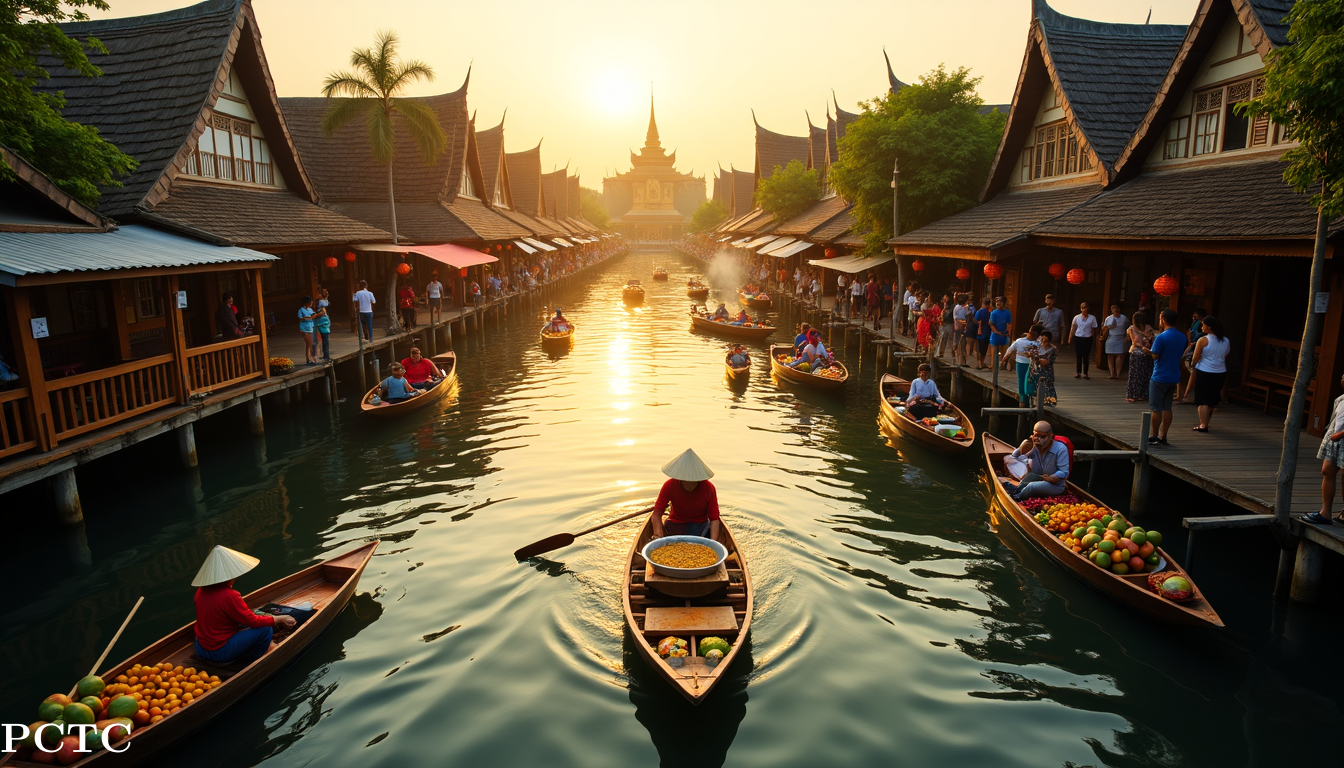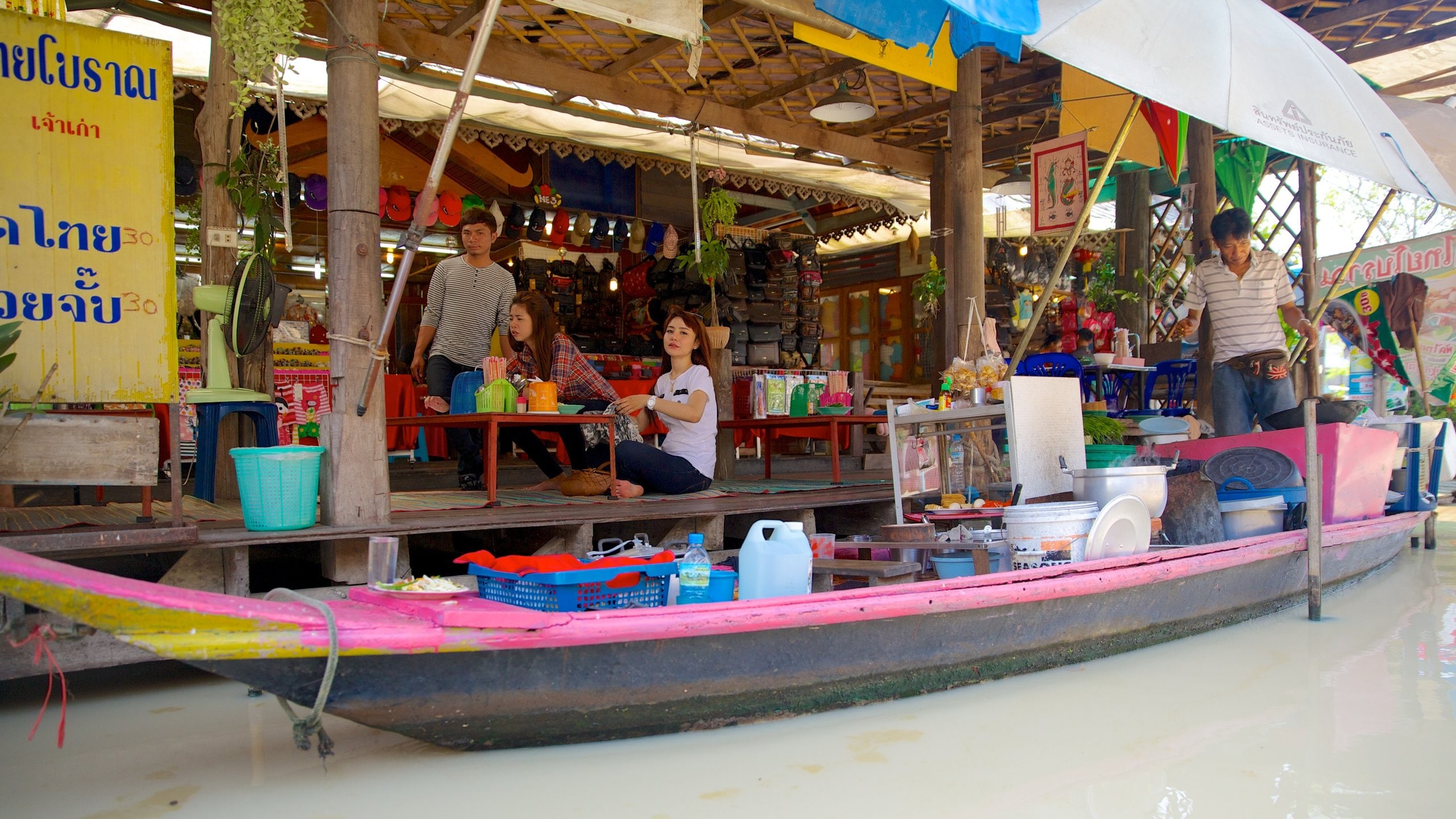
The Real Story Behind Pattaya Floating Market: Culture & Food Guide
Pattaya Floating Market is Eastern Thailand's largest freshwater pond, covering 100,000 square meters. This cultural hub has grown since 2008 and now features over 114 shops and water vendors that showcase a rich mixture of Thai heritage.
Most people might call it a tourist spot, but we found that this market serves as a living museum showcasing Thailand's four distinct regions. Visitors can experience genuine Thai riverside living through daily traditional performances, regional food, and cultural demonstrations.
The Origins and Reality of Pattaya Floating Market

Floating markets have become part of Thailand's identity. They offer a glimpse into an era when waterways shaped commerce and community life.
How traditional floating markets shaped Thai commerce
Thailand's extensive network of rivers and canals served as main transportation routes before modern roads altered the map. People called the country the "Venice of the East". These waterways became Thai commerce's backbone, where boats full of agricultural harvests and handmade goods would join to create lively, floating bazaars.
Traditional floating markets weren't just places to trade—they became vibrant social hubs. Communities gathered here to share stories and strengthen their cultural bonds. Thai riverside residents built wooden piers to moor their boats, which naturally became trading spots. Life in these aquatic societies revolved around canals. People relied on waterways for everything from transportation and fishing to daily commerce.
When and why Pattaya Floating Market was created

Pattaya Floating Market, 15 years old and officially named "Four Regions Floating Market", stands as a cultural showcase rather than a natural commercial development. This 100,000-square-metre attraction differs from traditional markets that grew organically. Designers carefully crafted it to showcase Thailand's four distinct regions: North, Northeast, Central, and South.
The market's main goal goes beyond tourism. It wants to preserve Thailand's "beautiful ancient Thai riverside living community and authentic ways of life". Though relatively new, its design captures the essence of centuries-old traditional floating markets for today's visitors.
The tourist attraction vs. authentic experience debate
The market's carefully planned nature creates ongoing debate about its authenticity. Critics say it works more like a "tourism trap" than a genuine cultural experience. Visitors hoping to find the spontaneous charm of historical floating markets often feel let down when they discover its manufactured character.
Reviews often point out price differences between locals and foreigners. Some visitors think the doesn't match what they get. Boat rides, which many see as crucial to the floating market experience, get mixed feedback about their value and length. 200 Baht entrance fee
The market succeeds in teaching visitors about regional Thai cuisines, crafts, and cultural performances. First-time visitors to Thailand find it a convenient way to experience various Thai traditions without travelling to multiple regions.
Northern Thailand Zone: Mountain Crafts and Cuisine
The Northern Thailand zone at Pattaya Floating Market takes you straight to a mountainous region rich with ancient craftsmanship and distinct flavors.
Traditional wooden handicrafts and silverwork

The northern section displays beautiful craftsmanship that has thrived for centuries in Thailand's mountainous areas. Visitors can see detailed wooden sculptures that showcase techniques passed down through generations. These skills first developed in the Lanna kingdom, where Buddhist temple wood carvings became the signature of northern artistic expression.
Northern Thai silver is famous for its exceptional purity—often reaching. The silverwork tradition started with ancient Hindu settlers and grew richer with influences from Burmese refugees and Shan tribes. The Karen tribe, one of Southeast Asia's largest hill tribes, has created traditional silver jewellery for centuries using age-old methods. You can watch artisans at the market create pieces with raised textures—a unique feature. 99.9silverware
Northern Thai food specialties to try
Your taste buds are in for a treat with northern Thai cuisine.
Here are some must-try dishes:
-
Khao Soi – a rich curry noodle soup that balances creamy coconut milk with aromatic spices
-
Sai Oua – northern Thai spicy sausage infused with lemongrass and galangal
These dishes represent the region's unique flavour profile, which stands apart from central or southern Thai cuisine.
Cultural performances representing Lanna heritage
Traditional Lanna dance performances engage visitors throughout the day with elegant movements and colorful costumes. These dances keep alive the cultural legacy of the ancient Lanna kingdom that once thrived in northern Thailand.
The performers' graceful hand gestures and measured steps tell stories of the region's mythology and daily life. The musical ensemble features unique traditional instruments like the "seung" (a plucked string instrument) and the "khim" (a hammered dulcimer).
Pattaya Floating Market brings these elements together to create an experience that celebrates northern Thailand's mountain heritage within this cultural showcase.
Central and Northeastern Thai Cultural Showcases
Pattaya Floating Market's central and northeastern sections showcase Thailand's most distinctive cultural experiences. These regions reveal flavors and heritage that stand worlds apart from each other.
Isaan flavors: Spicy dishes and regional specialties

The Northeastern (Isaan) zone brings Thailand's boldest flavors to life. Fiery spice levels, sour notes, and fermented fish (Pla Ra) define Isaan food that creates a unique atmosphere of community sharing. Chef Chalee Kader explains, "When Thai people have Isaan food, it's usually at the time they get together and share, like after work or even during merit-making."
Your food adventure should include:
-
Som Tam – The iconic green papaya salad pounds away in a stone mortar and creates the distinctive "pok pok" sound
-
Laab – A fiery minced pork salad mixes with shallots, coriander, and mint leaves
-
Sai Krok Isan – Fermented sausage combines pork and glutinous rice
-
Tom Saap – A deceptively simple yet complex spicy pork soup
Sticky rice takes the place of jasmine rice at most Isaan vendors. Small individual baskets serve this staple that pairs perfectly with these intensely flavored dishes.
Traditional silk weaving and textile demonstrations
Thai silk represents one of the country's most treasured textiles. Market demonstrations reveal the detailed process behind each piece. The sericulture cycle starts with silkworm cultivation and moves through harvesting cocoons, reeling, dyeing, and weaving.
Regional variations in weaving techniques capture visitors' attention. Demonstrations highlight mat mii (Thai ikat), chok from Central Thailand, and phrae wa from the Northeast.
Central Thailand's royal influence on display
Royal influence spreads through every display in the Central Thailand section. The monarchy's images, especially the revered late King Bhumibol Adulyadej, appear throughout—showing Thai people's deep respect for the royal family.
Cultural performances incorporate elements from traditional literature that kings originally supported. These shows bring stories like Khun Chang and Khun Phaen to life. Battle scenes, supernatural encounters, and humorous episodes fill these performances that laid the groundwork for today's popular television dramas.
The wai—Thailand's traditional greeting—demonstrates how respect levels shape even the simplest interactions in Central Thai culture. The depth of this gesture indicates the level of respect shown.
Southern Thailand Experience and Market Navigation
Pattaya Floating Market's southern region brings Thailand's tropical coastal heritage to life with bright colors, bold flavors, and a relaxed vibe.
Coconut products and southern Thai delicacies
Thai culture's "tree of life" - the coconut - stands proud in this market zone. People here call it a symbol of abundance and prosperity. The market's amazing selection of coconut products comes straight from central and southern Thai farms.
You can taste real coconut milk from pristine islands in Chanthaburi province. These islands are home to special MAWA coconut species. The southern zone also has pure products like coconut sugar, virgin coconut oil, coconut flour, and fresh coconut drinks - all chemical-free.
Food lovers shouldn't miss these southern treats:
-
Grilled seafood with southern spices
-
Coconut ice cream in coconut shells
-
Mango sticky rice that balances perfectly with spicy dishes
-
Brave souls can try the crocodile satay - it's quite an adventure
Best photo spots around the market
The market offers plenty of great photo spots. Traditional wooden buildings next to waterways create perfect picture backgrounds. The southern zone's boats filled with colorful tropical fruits make stunning photos.
Want that perfect Instagram shot? Head to one of the wooden bridges where canal paths meet. Cultural shows on floating stages also make great photo subjects.
Boat ride experience: What to expect and pricing
A boat ride gives you the best way to see this floating market. You can pick between a boat with a driver (great for 4-6 people) or paddle yourself.
Boat tours let you see waterfront shops and vendors you'd miss by walking. Rides usually take 5-30 minutes, with prices that vary quite a bit according to reviews. A boat trip costs about 800 baht, though people disagree on whether it's worth the money.
The best way to enjoy everything? Sit back in a wooden boat, eat some local food, and watch the market buzz with life. These moments become memories you won't forget.
Conclusion
Pattaya Floating Market is a remarkable mixture of Thailand's cultural heritage. This 100,000-square-meter attraction was built with tourists in mind, yet it beautifully preserves Thai traditions through four regional zones. Each section has its own character, showcasing everything from northern silverwork to the south's coconut treats.
The market might not be centuries old, but it gives visitors real-life cultural experiences through traditional shows, local food, and craft demonstrations. Boat rides cost different amounts but let you see waterfront life in ways that walking around just can't match.
You'll need at least half a day to see everything if it's your first visit. Want to check out this cultural hub yourself? for a smooth experience.Plan your visit through Pattaya City Tour
The 200 Baht entrance fee opens up a world where Thailand's old traditions spring to life. You can taste spicy Isaan dishes, watch skilled artisans weave silk, or capture photos of traditional wooden buildings. This market is a chance to experience Thailand's rich cultural heritage up close.
FAQs
Q1. What are the operating hours of Pattaya Floating Market? The market is open daily from 9:00 AM to 8:00 PM. For the best experience, consider visiting during sunset hours to enjoy beautiful lighting and a vibrant atmosphere.
Q2. Is there an entrance fee for Pattaya Floating Market? Yes, there is an entrance fee of 200 Baht per person to access the market. This fee allows you to explore all four regional zones and enjoy the cultural performances.
Q3. Can visitors explore the market on foot or only by boat? You can explore the market both on foot and by boat. Walking allows you to browse the shops along the elevated walkways, while boat rides offer a unique perspective of the waterfront vendors and activities.
Q4. What types of food can I expect to find at Pattaya Floating Market? The market offers a wide variety of regional Thai cuisines. You can sample northern specialties like Khao Soi, spicy Isaan dishes such as Som Tam, central Thai favorites, and southern delicacies including coconut-based treats and fresh seafood.
Q5. Are there cultural performances at the Pattaya Floating Market? Yes, the market features regular cultural performances representing Thailand's diverse heritage. You can watch traditional dances, music performances, and demonstrations of crafts like silk weaving throughout the day in different zones of the market.
